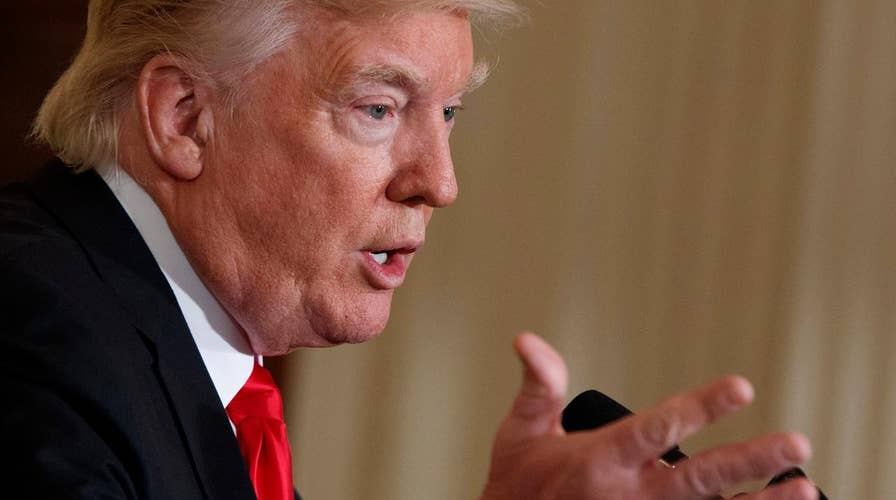I’m neither a foreign policy nor national security wonk, so I’ll leave it to others to weigh the geopolitical merits of President Trump’s immigration executive order.
But having dabbled in the black art of political message-crafting, what seems apparent is a line uttered by Strother Martin’s character in "Cool Hand Luke": “What we have here is a failure to communicate.”
And for a new White House looking at another firestorm later this week when it seeks to fill a Supreme Court vacancy: perhaps a teachable moment.
For the past week, the Trump administration was on top of its game: signing edicts left and right, meeting with foreign leaders, defying partisan orthodoxy by huddling with Democratic members of Congress and labor leaders normally in lockstep with the opposition party.
Collectively: driving the news, keeping its opponents off balance, playing offense rather than defense.
But the blowback after Trump issued his executive order – it restricts immigration from seven select countries, temporarily suspends refugee admission, and bars Syrian refugees indefinitely – proved the opposite.
The White House spent the weekend on defense, clarifying the order’s details and intent. As such, it was a reminder that some old rules of political communications still apply, even in this social media age.
Four of those rules:
1. Have a “Murder Board” Beforehand. The day after the executive order was issued, confusion broke out across the country as to the status of travelers in the U.S. and abroad caught in the immigration pipeline.
One likes to think the White House thought this – discussing what could and would go wrong – before the President put pen to paper. In politics, this is a variation of what’s called a “murder board” – a gathering of minds to walk through tough anticipated questions and minimize confusion.
Perhaps the Trump team did this. On the other hand, when senior advisors are offering clarification on Sunday talk shows, it suggests some more pre-planning might have been warranted.
2. Have Your Paperwork In Order. Trump issued the executive order on Friday. Appearing on Fox News Sunday, the Associated Press’ Julie Pace claimed that it took the White House two hours to get the press a copy of the order, hours more after that to produce a list of the affected countries, and not until the next day for in-depth briefings.
The lesson: speed is of the essence – both in feeding the media beast and getting the upper hand on defining a controversial policy’s narrative.
Which leads us to . . .
3. Have Your Talking Points Written and Circulated. One way to keep people on the same page: circulate a pageful of the points you want to emphasize.
If I had to choose four items to have driven home beginning on Friday: 1) it’s not a “Muslim ban” (#muslimban being the new #handsup as a dishonest Internet meme); 2) Trump isn’t the first president to restrict immigration by nation-state; 3) exemptions will be made in extraordinary cases; 4) it’s a moratorium, not a ban.
Those points are all being played up at present by the White House and observers looking past the emotional response to Trump’s action. But winning the argument means enlisting a larger number of voices.
And that requires . . .
4. Have Your Surrogates Lined Up. In today’s politics, complicated policies are fought in multiple arenas by multiple combatants – foreign-policy sages, legal constitutional scholars, columnists, bloggers, partisan hacks.
A White House can hope for the support of those it assumes to be sympathetic, or pro-actively reach out for their support.
Some casual Internet surfing shows support for Trump’s action in places you might expect it (the conservative blogosphere) and some crannies you wouldn’t (National Review’s David French, almost a third-party stop-Trump candidate in 2016, wrote one of the best clarifications of facts versus hysteria).
Is the Trump White House a quick learner? We’ll find out soon enough when the president reveals his choice to replace the late Justice Antonin Scalia on Tuesday night at 8pm ET.
Let’s see then how the rules play out. Will the White House have a message ready to go, explaining why the new pick is not just qualified but mainstream acceptable? Will it get its talking points to its supporters? Will it have conservative scholars and thought-leaders lined up in defense of a choice that’s certain to encounter liberal resistance (and perhaps obstruction)?
Historically, that’s how previous administrations have approached Supreme Court fights. In this case, it one’s Washington tradition the Trump White House should continue.

